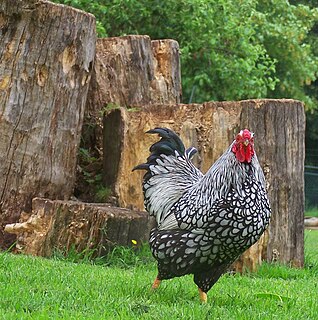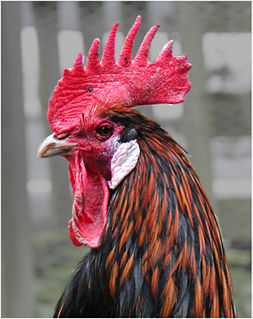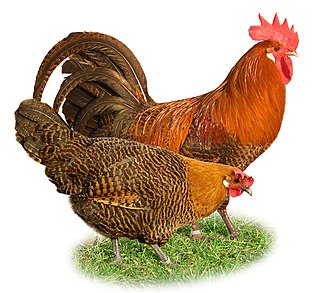
The Leghorn is a breed of chicken originating in Tuscany, in central Italy. Birds were first exported to North America in 1828 from the port city of Livorno, on the western coast of Tuscany. They were initially called "Italians", but by 1865 the breed was known as "Leghorn", the traditional anglicisation of "Livorno". The breed was introduced to Britain from the United States in 1870. White Leghorns are commonly used as layer chickens in many countries of the world. Other Leghorn varieties are less common.

The Brahma is a large breed of chicken developed in the United States from birds imported from the Chinese port of Shanghai. The Brahma was the principal meat breed in the United States from the 1850s until about 1930.

The Wyandotte is an American breed of chicken developed in the 1870s. It was named for the indigenous Wyandot people of North America. The Wyandotte is a dual-purpose breed, kept for its brown eggs and its yellow-skinned meat. It is a popular show bird, and has many color variants. It was originally known as the American Sebright.

The Hamburg, Dutch: Hollands hoen, German: Hamburger, is a breed of chicken which is thought to have originated in Holland sometime prior to the fourteenth century. The name may be spelled Hamburgh in the United Kingdom and in Australia.

The Lakenvelder or Lakenfelder is a breed of domestic chicken from the Nordrhein-Westfalen area of Germany and neighbouring areas of the Netherlands. It was first recorded in 1727.

The Sebright is a British breed of bantam chicken. It is a true bantam – a miniature bird with no corresponding large version – and is one of the oldest recorded British bantam breeds. It is named after Sir John Saunders Sebright, who created it as an ornamental breed by selective breeding in the early nineteenth century.

The Campine is a breed of domestic chicken originating in the northern part of Belgium. It is named for the Campine region of north-eastern Belgium and south-eastern Netherlands. It was known there as the Kempisch Hoen.

The Faverolles is a French breed of chicken. The breed was developed in the 1860s in north-central France, in the vicinity of the villages of Houdan and Faverolles. The breed was given the name of the latter village and the singular is thus also Faverolles, not Faverolle. Since the final “s” is silent in French, this is only necessary when writing the name.

The Scots Grey is a dual-purpose breed of domestic chicken originating in Scotland, where it has been bred for more than two hundred years. It was formerly known as the Scotch Grey and until about 1930 was popular in Scotland. It is on the "Native Poultry Breeds at Risk" list of the Rare Breeds Survival Trust.

The Brabanter is a Dutch breed of crested chicken originating in the historic region of Brabant which straddles Belgium and the Netherlands. It is an ancient breed and is shown in 17th-century paintings. A bantam Brabanter was created in around 1934.

The Schweizer, German: 'Schweizerhuhn' or "Swiss chicken", is a Swiss breed of domestic chicken. It was bred in 1905 in Amriswil, in the canton of Thurgau, in north-east Switzerland. It is kept mainly in German-speaking areas of the country.

The Westfälischer Totleger is a German breed of domestic chicken. It is more than 400 years old, and is a rare breed.

The Bergische Kräher is a German breed of domestic chicken from the Bergisches Land, in the state of North Rhine-Westphalia in western Germany. It is named for its unusually long crow, up to five times as long as that of other breeds, and belongs to the group of long-crowing chicken breeds, which are found from south-east Europe to the Far East.
The Pépoi or Pepoi is a rustic dual-purpose breed of small chicken from north-eastern Italy, particularly the Veneto and Friuli-Venezia Giulia regions. It is not officially recognised as a breed in Italy, but is being considered for recognition.
The Mugellese, also known as Mugginese, is a rustic dual-purpose breed of small chicken or bantam from Tuscany, in central Italy. It takes its name from the Mugello, an area to the north-east of Florence. It is not officially recognised as a breed in Italy, but is being considered for recognition.

The Friesian or Frisian, Dutch: Fries Hoen, is an ancient Dutch breed of chicken. It originates in Friesland, on the North Sea coast of in the northern Netherlands.

The Bergische Schlotterkamm is an old and endangered German breed of domestic chicken. It originates from the Bergisches Land, in the state of North Rhine-Westphalia in western Germany, and is one of three chicken breeds from that area, the others being the Bergische Kräher and the Krüper.

The Augsburger is an endangered German breed of domestic chicken. It originates from the area of the city of Augsburg, in the Swabian region of the state of Bavaria, in southern Germany. It was bred in the nineteenth century, and derives mostly from the French La Flèche breed. It is the only chicken breed of Bavarian origin.
Sombor Kaporka is a breed of chicken، the breed is also called "The Sombor Crested chicken" and "Somborska kaporka" or simply "Somborska", Originally from serbia and was largely developed at the beginning of the 20th century in Vojvodina in the town of Sombor, in Serbia, by interbreeding domestic chicken with Houdan and Sulmtaler chicken.






















